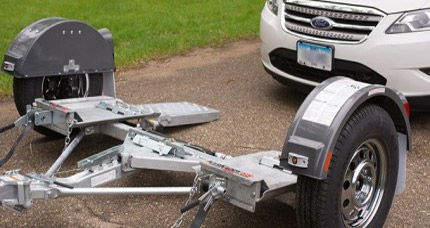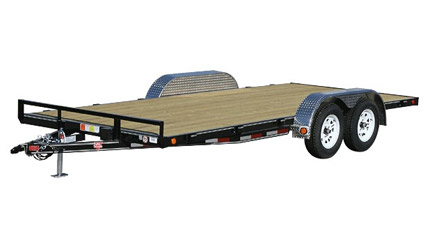Tow Bars and Towing Accessories Calgary

Tow Bars
The tow bar assembly transports vehicles — standard or automatic transmission — with all four wheels touching the ground. In general, tow bars are the easiest to use and the least expensive of the towing systems. Most tow bars are rated in classes from 5000 pounds to 10,000 pounds, sufficient to handle most any towed vehicle.
The system usually consists of two elements: the tow bar (or wishbone portion) and the base plate, which attaches to the chassis of the towed vehicle. The base plate is custom-made for a particular vehicle and provides a safe point of attachment for the tow bar.
Many manufacturers offer motorhome-mounted tow bars that remain attached to the motorhome and connect to the towed vehicle only when the car is being pulled. This type offers the the advantage of a built-in storage location and a cleaner-looking towed vehicle. Folding models that can be flipped and stowed horizontally or vertically on the base plate of the towed vehicle are also available.
Disadvantages: Tow bar assemblies, at least the base plate portion, tend to be unique to a particular vehicle. If a base plate does not already exist for your vehicle, custom installations can be expensive. Mileage accumulates on vehicles when they are being towed four wheels down, unless they are equipped with an electronic speedometer or a speedometer disconnect. Some vehicles cannot be towed in this manner without drivetrain modifications. With most tow bar systems, the motorhome cannot be backed up when the towed vehicle is attached.
While tow dollies and trailers come with lights, motorhomers who use a tow bar must use a tow light kit or wire into the towed vehicle’s lighting system.

Tow Dolly
A short, two-wheeled trailer that transports the towed vehicle with two of its wheels off the ground. The dolly is first coupled to the motorhome. Then the towed vehicle is driven up the ramps so that the two drive wheels rest on the dolly and the other two wheels are on the ground. The toad is then secured to the dolly with straps and/or chains. Tow dollies are not applicable to rear-wheel-drive vehicles, because vehicles should not be towed backward.
The advantages of the tow dolly system are its universality (the same dolly can be used to tow a variety of vehicles) and the fact that it can be used to tow many vehicles that cannot be towed four wheels down. Disadvantages: Tow dollies are relatively expensive to purchase, and the hookup procedure can be elaborate. In addition, tow dollies cannot be backed up easily, and the motor coach owner must find a place for the dolly once he or she arrives at a destination. Most states require licensing of dollies and trailers.

Trailer
A trailer makes it possible to tow a vehicle with all four wheels totally off the ground. This eliminates concerns about automatic transmission damage and odometer mileage accumulation and saves wear and tear on the body and tires of the towed vehicle. If a base plate is not available for towing four wheels down, or if you want to tow more than one vehicle that you own, a trailer might be the best option. It offers backing up capability, and many trailers (and tow dollies) come equipped with brakes. Disadvantages: Loading and unloading the trailer can be cumbersome and time-consuming. The coach owner might have to find a place to store the trailer upon arrival at an RV park or other destination. Also, the trailer is added weight that must be considered.

